Looking for great ways to help students learn to work together, listen carefully, communicate clearly, and think creatively? Try some of these team-building games and activities. They’re a super way to give your students the chance to get to know one another, build trust as a community, and, best of all, have fun! Below we’ve gathered 38 team-building games and activities for the classroom. And if you’re looking for online team-building activities, we have those too!
Watch the video below to see three of our favorite in-person team-building games in action, then read on for more ideas.
1. Seeing spots
For this activity, you’ll place a colored sticker dot (blue, red, green, or yellow) on each student’s forehead without them knowing what color it is. When the game begins, each “team” of students (with the same color) must find each other—without speaking. This is a wonderful team-building activity because it encourages non-verbal communication and cooperation.
2. Common thread
Divide students into groups of four and have them sit together in these small groups. Give each group five minutes to chat among themselves and find something they all have in common. It could be that they all play soccer, or pizza is their favorite dinner, or they each have a kitten. Whatever the common thread, the conversation will help them get to know one another better. Check in with the groups after five minutes to see if they need more time. After each group has come up with their common element, have them work together to create a flag that represents it.
3. Four-way tug-of-war
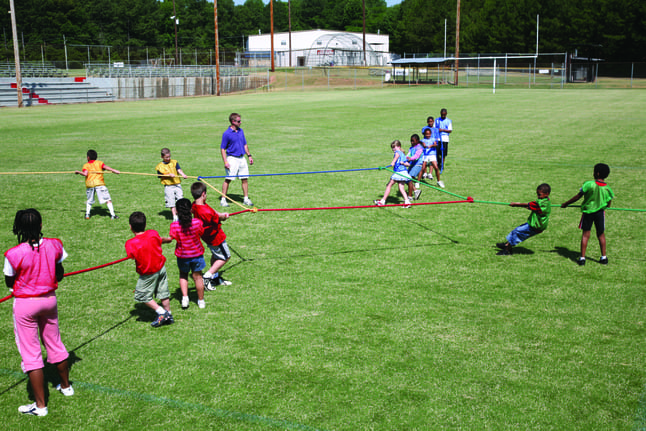

Source: School Specialty
This classic outdoor activity is double the fun of the traditional tug-of-war. Tie two long jump ropes together at their center points, creating an X shape. Tie a bandanna around the center point. Next, use cones to form a circle that fits around the X. Form four equal teams, and have each team stand at one of the four ends of the ropes. At your signal, each team begins pulling. The objective is to be the first team to pull the others in their direction far enough for the bandanna to cross to the outside of the circle of cones. Students who feel nervous about participating can serve as referees who make sure everyone is safe.
4. Classification
For this activity, prepare a tray with 20 unrelated items—for instance, a spool of thread, an eraser, a juice box, etc. Alternatively, create a document with 20 images of items to put up on the screen. Divide your class into even groups. Set a timer and have each group divide the 20 items into four categories that make sense to them. For example, they may put an earring, a glove, a headset, a sock, and a smile into the category “things you wear.” Have groups work quietly so that their ideas are kept secret. When each group is finished, give each one time to present their categories and their rationale behind each category.
5. Railroad tracks
Lay out two long ropes parallel to each other and have students line up in the middle. Call out a set of opposites like sweet or sour, day or night, cat or dog. Students will jump over the left rope if they prefer the first one or over the right rope if they prefer the second one. Give them a minute to look around, then have everyone return to the middle. This activity is a good way to get to know classmates better and to see who they have preferences in common with.
6. Balloon walking
Have your students pair up side-by-side and hold hands. Then place a balloon in between the shoulders of each pair. The object of the activity is for the entire class to walk in a line without any of the balloons popping or falling to the ground. It’s heaps of fun!
7. Hot seat
This fun game is a lot like the game show Password. Split your class into two teams and have them sit together in teams facing the whiteboard or chalkboard. Then take an empty chair—one for each team—and put it at the front of the class, facing the team members. These chairs are the “hot seats.” Choose one volunteer from each team to come up and sit in the “hot seat,” facing their teammates with their back to the board.
Prepare a list of vocabulary words to use for the game. Choose one and write it clearly on the board. Each team will take turns trying to get their teammate in the hot seat to guess the word, using synonyms, antonyms, definitions, etc. Make sure team members work together so that each member has a chance to provide clues.
The student in the hot seat listens to their teammates and tries to guess the word. The first hot seat student to say the word wins a point for their team. Once the word is successfully guessed, a new student from each team sits in the hot seat, and a new round begins with a different word.
8. Line up
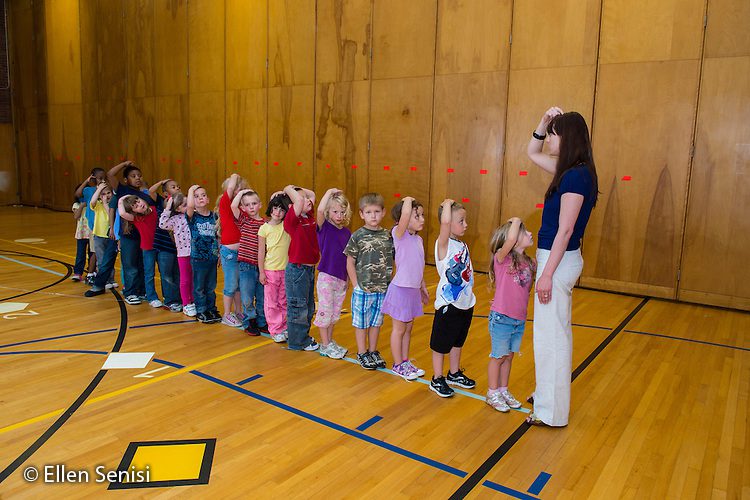

Source: Ellen Senisi
Did you know there are team-building games and activities that can help teach students how to line up? It may take 5 to 10 minutes, depending on the age of your students, so plan accordingly. The objective is to have students line up in order of their birthdays—January 1 through December 31. To do this, they will need to know the order in which the months fall as well as their own birthday. They will also need to talk with one another in order to figure out who goes in front of whom. To make it super challenging, tell them they must do it without speaking at all, only using hand signals. Other ways to line up include by height, alphabetically, or by foot size.
9. The perfect square
This activity requires strong verbal communication and cooperation. All you need is a long rope with the ends tied together and something to serve as blindfolds for students, such as bandannas or fabric strips. Have students stand in a circle holding the rope in front of them. Signal them to put their blindfolds on and set the rope on the ground in front of them. Ask students to turn and walk a short distance away from the circle. Assign a partner to any students who may need help. Finally, have everyone come back to the rope and try to form a perfect square with their blindfolds on. Set a time limit to make it more challenging.
10. Rock, paper, scissors tag
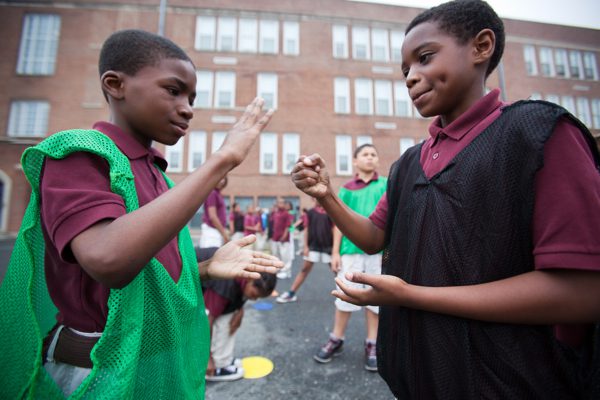

Source: Playworks
You’ll need some space for this activity. Divide students into two teams. Before you begin, stake out the boundaries and position a home base at either end for each team. For each round, each team must confer and decide whether they will be rock, paper, or scissors. Have the two teams line up facing each other, and on your signal, have all players flash rock, paper, scissors, shoot! The kids on the losing team must run back to their base before they are tagged by one of the kids on the winning team.
Or try this fun, kid-created version filmed by Coach Leach.
11. Flip-the-sheet challenge
Looking for creative-thinking team-building games and activities? Divide students into two teams. One team will do the challenge first while the other team watches, then they will switch places. Have all members of the team stand on a flat bedsheet, tarp, or blanket (kids should fill up all but about a quarter of the space). Challenge the team to flip over the sheet/tarp so that they are standing on the other side of the sheet/tarp without stepping off or touching the ground.
12. “Get to know you” balloons
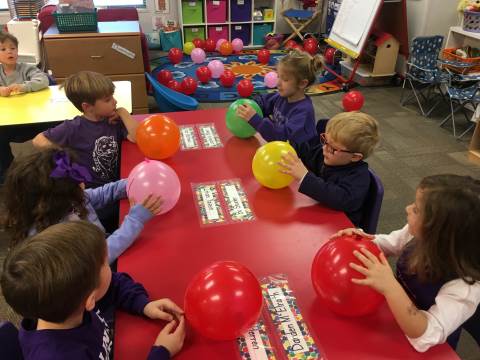

Source: Darlington Schools
Give each student an empty balloon and a slip of paper. Ask them to write a get-to-know-you question on their paper, such as How many brothers and sisters do you have? Do you have any pets? What’s one fun thing you did this summer? Next, have them put their question inside the balloon, blow it up, and tie the end.
When everyone is ready, have them gather on the rug and, on your signal, toss their balloon up in the air. Give them a couple of minutes to bat the balloons around, then call stop. Have each student grab one balloon and come sit in a circle. Go around the circle and, one at a time, have students pop their balloon, read the question inside, and answer the question. This is one of those team-building activities students will always remember.
13. Marshmallow-and-toothpick challenge
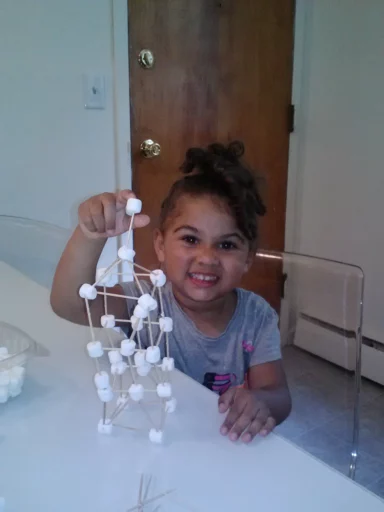

Source: Jady A.
Divide students into groups of equal numbers. Pass out an equal number of marshmallows and wooden toothpicks to each group. Challenge the groups to create the tallest, largest, or most creative structure in a set amount of time, each member taking turns doing the actual building. Afterward, have each group describe what they made.
14. Sneak peek
Need team-building games and activities that focus on problem-solving? This activity will help students learn to communicate effectively. Before the game begins, build a small sculpture with LEGO bricks or building blocks and keep it covered in an area that is of equal distance from all the groups. Divide your students into teams of four or five, and give each team enough blocks to duplicate the structure.
To begin the game, reveal the structure, and one member from each team is allowed to come up to look at it closely for 10 seconds, trying to memorize it before returning to their team. Once they return to their team, they have 25 seconds to instruct the group on how to build a replica of the structure. After one minute of trying to re-create it, another member from each team can come up for a sneak peek before returning to their team and trying again. The game continues until one of the teams successfully re-creates the original structure.
15. Art reproduction puzzle
Divide students into groups of six or eight (or larger if you want to make the task more difficult). Provide each team with an image and blank pieces of white card stock, one per team member. First, each team must cut up the image into the same number of pieces as there are group members. Then, each player will take one of the pieces of the image and reproduce it onto their blank piece of card stock with pencils, colored pencils, or markers. (If the team cuts the image into irregularly shaped pieces, each team member must then cut their blank paper into the same shape.) When every team has created the pieces of their puzzle, they will switch pieces with another team. The team will work together to solve the puzzle.
16. Hula-Hoop pass
Source: Parma Preschool
This activity helps kids work on listening, coordinating, and strategizing skills. It works best with smaller students. Have your students stand in a big circle. Place a Hula-Hoop on one student’s arm and have them join hands with the student next to them. Ask all the other students to join hands to close up the circle. The objective of the game is to pass the Hula-Hoop all the way around the circle without unclasping hands. Students will have to figure out how to maneuver their bodies all the way through the hoop to pass it on.
17. Eye contact
Are you looking for team-building games and activities to support nonverbal communication skills? Choose ten students to participate in the first round. The others can gather around the edges and watch. Designate a player one. To begin, player one makes eye contact (no words or hand motions) with another player (player two) and gives them a signal that means go. When player two says go, player one starts moving slowly toward them to take their place in the circle. Player two then makes eye contact with another player (player three) and gives them a signal meaning go, and starts moving toward them. The objective of the game is to time each player’s command so that each player makes space for the others in time. After the first round, switch out the teams until everyone has had a chance to play.
18. Fingertip Hula-Hoop
In this game, your students stand in a circle and raise their arms with only their index fingers extended. Place a Hula-Hoop so that it rests on the tips of the children’s fingers. Tell the students they must maintain a fingertip on the Hula-Hoop at all times, but they are not allowed to hook their finger around it or otherwise hold the hoop; the hoop must simply rest on the tips of their fingers. The challenge is for the children to lower the hoop to the ground without dropping it. To make this more challenging, you can place communication constraints on the children—no talking or limited talking, for example. Watch the video for a demonstration.
19. Mingle, mingle group
This activity is good for encouraging kids to mix it up. Students mill about the room saying, in a quiet voice, “Mingle, mingle, mingle.” Then, you call out a group size, for example, groups of three. Students must break into groups of that size. The goal is to form different groups of individuals every time. If a person tries to join a group with whom they have already partnered, they must find a different group. After a few rounds, the process may take a bit of rearranging.
20. Bumpity-ump-bump-bump
This is a fun name game that requires quick thinking! Students stand in a large circle. One student comes to the middle. That student walks around the inside of the circle, stops in front of one person, and gives them a direction. There are four choices: Left = say the name of the person to the left; right = say the name of the person on the right; it = say the name of the person who is it; or self = say one’s own name. After you give the student the direction, the designated person says “bumpity-ump-bump-bump!” out loud. The student who was given the direction races to say the name of the correct person before the student finishes the phrase. If they can’t, they’re the next person on the inside of the circle.
21. Group hop
This activity requires coordination and communication. Divide students into groups of four to six people. Have the students in each group stand in a straight line with their right hand on the shoulder of the person in front of them and their left leg forward so that the person in front of them can hold their ankle. The group then sees how far they can hop along together without toppling over. Once groups get the hang of hopping, you can hold a competition to see who can hop the farthest or longest.
22. No-hands cup-stacking challenge
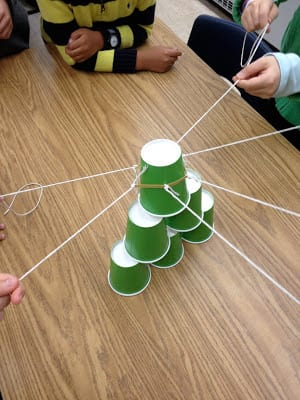

Source: Nick Cornwell
If you’re looking for hands-on team-building games and activities that work for groups, try this challenge. It’s an exercise in patience and perseverance, not to mention a total blast! Decide how many students you want in each group and tie that number of strings to a single rubber band, making one for each group. Each person in the group holds on to one of the strings attached to the rubber band, and, as a group, they use this device to pick up the cups (by expanding and contracting the rubber band) and place them on top of each other in order to build a pyramid. See detailed instructions here.
23. Tick tock
This activity helps students negotiate and work together toward a common goal. Make a list of tasks on chart paper, assigning a point value for each job. For example: Do 25 jumping jacks (5 points); make up a nickname for each member of the class (5 points); get every person in the class to sign a piece of paper (15 points); form a conga line and conga from one end of the room to the other (5 points, 10 bonus points if anyone joins you); etc. Make sure you list enough tasks to take up more than 10 minutes. Divide your students into groups of five or six and give them 10 minutes to collect as many points as they can by deciding which tasks from the list to perform.
24. Body parts
Looking for team-building games and activities where students mingle around the classroom? In this game, they move around the room calling out a body part and a number, for instance, “four knees!” Students have to form a group of four students closest to them (finding new partners each time) and join together one knee each or a group of two with both knees together. Anyone who isn’t part of a group gets to call the next round.
25. Human alphabet
If you have a large open space for your team-building games and activities, try this idea. Have students spread out and guide them through a few rounds of forming letters with their bodies. For instance, “Use your body to make a T … now make an O!”
Next, call out a simple short word, such as “so” or “dog.” Students will have to team up to form the word, with each student using their body to form one of the letters. Start with two-letter words, then three, then four. If students want a challenge, come up with a phrase that will take the whole class to complete.
26. Applause, please
Form groups of three to five students. One person from each group (the finder) steps out of the classroom. The rest of the group picks an object (for instance, the pencil sharpener) in the classroom for the finder to find. When the finder comes back in, they begin walking around the classroom in search of the object. The others cannot say anything, but they can give hints by using applause to lead the finder in the right direction. If the finder is far away from the object, the group will clap slowly and softly. When the finder gets close, the group will applaud faster and more loudly until the finder picks the correct object.
27. Caterpillar
Divide students into groups of four. Lay out four Hula-Hoops per group and have one student stand in the center of each one to form teams of “caterpillars.” Line all of the teams up at the end of a field or large open space. Set out four or five objects in front of the lines, such as cones, foam blocks, or balls.
The goal of the game is to collect as many objects as possible by moving the caterpillar forward. To move forward, the last player in line steps into the hoop with the player in front of them, picks up their empty hoop, and passes it overhead to the front of the line. The front player then places the hoop on the ground in front of them and steps into it. Every player then shifts forward, moving the caterpillar. Only the front player may pick up objects, but it is the team’s job to carry the collected objects throughout the game. The game ends when there are no more objects on the ground. Find more detailed instructions here.
28. Golf ball trampoline
Divide the class into teams of six or eight. Provide each team with a large bedsheet or tarp that has several slits cut into it, and have students hold on to the edges and spread the sheet out so that it is tight. Place a golf ball in the center of the sheet. Students must work together to maneuver the ball around the sheet without having it fall through one of the slits. When a team’s ball falls through, they are out and must sit until there is only one team left. Mix up teams and start over again.
29. Shrinking lifeboat
For this activity, you will need a few jump ropes. Divide students into groups of six or eight. Have each group make a circle with their jump rope (their “lifeboat”) on the ground so that the ends are touching. Now have all the members of each group get into their lifeboat. This should be easy the first time. Then have all players get out and reduce the size of their circle by one foot. Again, all players need to get into the boat. Repeat this process, making the lifeboat smaller and smaller while you watch your students come up with creative solutions for making sure that everyone fits safely inside their boat.
30. Pretzel, unpretzel


Source: Icebreaker Ideas
Divide your class in half and have each group choose one pretzel maker and two unpretzelers. Direct the unpretzelers to turn their backs. Have the rest of the students in each group form a circle and hold hands. Now, have the pretzel maker direct the students (with words only) to twist around, step over, and duck under one another’s arms to form a human pretzel. Once they are sufficiently twisted, call the unpretzelers over and have them try to direct the students (with words only) in order to untangle them. Students cannot drop their hands at any time. The first team that successfully unpretzels their group wins.
31. Creative solutions
This activity encourages creative problem-solving. Pick four or more different objects, such as a coffee can, a potato peeler, a knit hat, and a book. Split students into even teams. Now present a situation where each team has to solve a problem using only those objects. These scenarios can be anything from students who are stranded on a desert island and must find a way to get off or survive to students must save the world from Godzilla. Give the teams five minutes to figure out an original solution to the scenario, including ranking each object based on its usefulness. When the five minutes are up, have each team present their solution along with their reasoning to the class. (Tip: Don’t make the scenarios so easy that it is obvious which objects will be most useful.)
32. Zip, zap, zop
Here’s an option for team-building games and activities about focus and energy. As students pass the energy across the circle (in the form of a zip, a zap, or a zop), they make eye contact with the person they send the energy to and work together to keep the rhythm going. To pass the energy, have students put their hands together in a teepee in front of their chest. Player one moves their hands away from their chest, makes eye contact with and points at a classmate, and says “zip.” Then that student repeats the process with another student and says “zap.” That player repeats with a “zop,” then it starts all over with “zip.” Make sure students are making eye contact when they pass the energy. To make sure everyone is picked, students can put their hands down at their sides after their turn.
33. Spider web
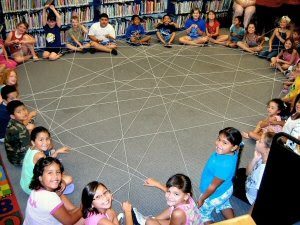

Source: Fabulous Fabris
This team-building game will teach your students that even though they may be different in many ways, they are still connected to one another. Gather in a circle, standing or sitting. The game begins when the first person, holding a large ball of twine, tells the group a funny or embarrassing story about themselves. Once they finish, they will hold on to the end of the twine and throw the ball to someone else in the circle. That person grabs hold and tells a funny or embarrassing story about themselves and then passes it on to another student. Play continues until the twine has been passed to each person. The end result will produce a “spider web” out of the twine, connecting each student to all of the others.
34. Newspaper fashion show


Source: Mommy Lessons 101
This is a great way to incorporate upcycling into your team-building games and activities. Divide students into groups of five or six, then give them a stack of newspapers, tape, and scissors. Set a timer and ask them to create the most fashionable outfit using only the supplies given. When time is up, have each group designate a model for the outfit, and have the group share information about the outfit. Once everyone shares, put on some rocking music and have a mini fashion show.
35. Back-to-back drawing
Need team-building games and activities that build communication skills? Ask students to pair up and sit back-to-back with their partner. Give one student a blank piece of paper and a pen or a marker. Give the other student a piece of paper with a simple drawing on it. The kid who receives the illustration will verbally describe the drawing to their partner. The other kid must draw the illustration by listening to the verbal instructions alone.
36. Changing tableau
Ask for five or six volunteers to come up to the front of the class. Divide the rest of the students into two teams and have them sit together. Have the students up front arrange themselves into a tableau. Give the two teams a short time to observe the tableau, trying to memorize their physical arrangement. After a couple of minutes, ask every person on both teams to face away from the team up front. The tableau team will decide on one thing to change about the tableau. When they are rearranged, the teams can turn around and try to figure out what changed. The first team to spot the difference gets a point. Continue play until one team receives ten points.
37. Straw challenge
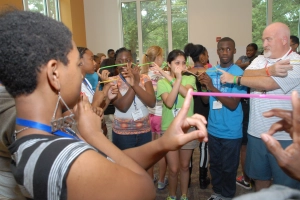

Source: Guide, Inc.
If you’re looking for team-building games and activities that require coordination and cooperation, try this one. Have your students form a large circle and give each one a plastic straw. Holding their straw in their right hand, have them cross their arms in front of them so their right hand is near their left shoulder and their left hand is near their right shoulder. The objective of the challenge is to balance each straw between one person’s right pointer finger with the left pointer finger of the person next to them. Try making some movements such as rotating the circle to the left or right, raising one foot, etc. The challenge is to keep the connection of straws intact.
38. Group Juggle
Have students circle up and have a supply of small plastic balls at the ready. Start by tossing one ball from person to person in the circle. After a minute, add in another ball. Instruct students to mindfully toss the ball, avoiding a collision. After another minute, add in another ball. Continue adding balls in each minute to see how many balls your students can successfully juggle.



















